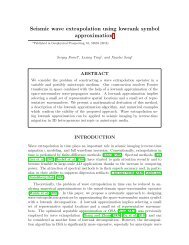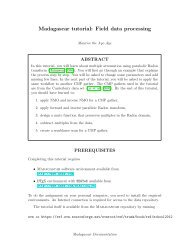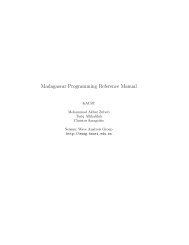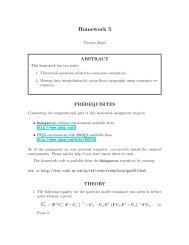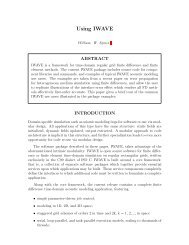Applications of plane-wave destruction filtersa
Applications of plane-wave destruction filtersa
Applications of plane-wave destruction filtersa
Create successful ePaper yourself
Turn your PDF publications into a flip-book with our unique Google optimized e-Paper software.
Fomel 8 Plane-<strong>wave</strong> destructors<br />
detection measure. Comparing the residual plot in Figure 3 with the analogous plot<br />
<strong>of</strong> Claerbout (1994, 1999), reproduced in Figure 4, establishes a superior performance<br />
<strong>of</strong> the improved finite-difference destructors in comparison with that <strong>of</strong> the local T -X<br />
prediction-error filters.<br />
Figure 2: Synthetic sedimentary model. Left plot: Input data. Right plot: Its texture.<br />
The texture is computed by convolving a field number with the inverse <strong>of</strong> <strong>plane</strong>-<strong>wave</strong><br />
<strong>destruction</strong> filters. It highlights the position <strong>of</strong> estimated local <strong>plane</strong> <strong>wave</strong>s.<br />
The left plot in Figure 5 introduces a simpler synthetic test. The model is composed<br />
<strong>of</strong> linear events with two conflicting slopes. A regularized dip field estimation<br />
attempts to smooth the estimated dip in the places where it is not constrained by<br />
the data (the left plot <strong>of</strong> Figure 6.) The effect <strong>of</strong> smoothing is clearly seen in the<br />
texture image (the right plot in Figure 5). The corresponding residual (the right<br />
plot <strong>of</strong> Figure 6) shows suppressed linear events and highlights the places <strong>of</strong> their<br />
intersection. Residuals are large at intersections because a single dominant dip model<br />
fails to adequately represent both conflicting dips.<br />
The left plot in Figure 7 shows a real shot gather: a portion <strong>of</strong> Yilmaz and Cumro<br />
(1983) data set 27. The initial dip in the dip estimation program was set to zero.<br />
Therefore, the texture image (the right plot in Figure 7) contains zero-dipping <strong>plane</strong><br />
<strong>wave</strong>s in the places <strong>of</strong> no data. Everywhere else the dip is accurately estimated<br />
from the data. The data contain a missing trace at about 0.7 km <strong>of</strong>fset and a slightly<br />
shifted (possibly mispositioned) trace at about 1.1 km <strong>of</strong>fset. The mispositioned trace<br />
is clearly visible in the dip estimate (the left plot in Figure 8), and the missing trace<br />
is emphasized in the residual image (the right plot in Figure 8). Additionally, the<br />
residual image reveals the forward and back-scattered surface <strong>wave</strong>s, hidden under<br />
SEP–105




